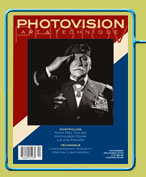Picture Maker or Picture Taker?
| By: Robert Hirsch and Greg Erf From Vol. 2 No. 4 |
Why is it that photographers often travel to exotic locations and use mexpensive equipment and are still disappointed with their photographs? Usually it is because the photographs only represent and replay the familiar. To get beyond a literal and mundane representation a photographer has to recognize and understand the forces that shape a photograph and take appropriate measures to master and incorporate them into the work. This article describes one strategy on the road to become a picture maker instead of a picture taker. Some people get involved with photography because its immediacy gives the illusion that it does not require a high level of skill. This myth has been perpetuated since Kodak’s 1880s marketing slogan “You push the button, we do the rest” to the more recent “Can’t draw, become an artist with a Nikon FM2,” which continues to feed the perception that technology can make photography accessible to all. Although the rudiments of photography can be quickly learned, optics and technology do not make good photographs. People make good photographs and it takes time to acquire knowledge of the aesthetics, materials, and processes. To cultivate a personal photographic vision one must go through three developmental phases.
Phase One: Craft and Science. Most people begin photographing their friends, family, and possessions out of the desire to share what is personally important with others. These photographs are documents that those close to you acknowledge as being good because of their own personal connection to the subjects and not because the photographs necessarily provide them with new insights into these subjects. The images themselves represent an initial attempt to visually communicate and the praise of friends reinforces the pre-existing aesthetic.
This is fine for people who only take photographs during special circumstances and are content with what an automatic camera can deliver. To make engaging imagery that visually communicates a message one must start thinking differently about what the goals of making the photographs are and commit to achieving them.
Phase Two: Natural Selection. Neophyte photographers natural tendency is towards literalism. They photograph an entire scene because they are not sure what is the real source of their interest. Simple cropping exercises, making natural selections, allow one to discover and isolate what is personally important. Once a subject has been identified carefully observe it and then photograph the vital parts that define its visual essence. Recall photographer Garry
Winogrand’s remark that photography is about where you put your feet. Point of view plays a significant role in making good photographs. Generally this entails getting closer to the subject, walking around it, and viewing it from different angles. Making selections removes extraneous information and will guide you to define what is personally important. Paying close
attention to the pictorial ingredients that interest you—light, color, line, repetition, shape, texture—will determine your internal aesthetic direction. This exercise reveals that photography’s compositional cornerstone is subtractive composition. Photogra-phers begin with everything, the camera records in its line of vision, deciding what to eliminate through subtraction directs viewers to what is of visual importance. Selecting and isolating these meaningful elements that take a photograph beyond a literal rendition requires a mastery of camera techniques and design elements. Depth-of-field, exposure, and design principles are tools one must become proficient in to take a subject beyond the average interpretation. This means expanding your knowledge of aesthetics, how images are constructed, art and photographic history, and presenting your work to others to critically analyze. This entails being open to change and suggestions. Using writing, as described in our previous series of articles, can further assist you in exploring the meaning of your work. Growth also means leaving certain things behind such as the adulation from your usual audience. Experimenting with new ideas and materials along with getting involved with other photographers and artists to discuss your work becomes critical for future growth.
Phase Three: Finding Your Place. Depending on one’s timetable and level of exploration it can take from one week to several years to get through the first two phases. The natural inclinations that govern personal photographic choices occur without questioning or understanding of these selections and can cause confusion when searching for a new direction. This can be simplified by choosing one subject area, such as landscape or portraits, to investigate and focusing your attention on one primary compositional device such as line or shape. It is the process of investigation (the doing) and not the photographs (the results) that will help the discovery of new ways to make better photographs. Later these finding can be applied to other subjects and your base of compositional elements expanded. The goal is to find your place by achieving a clear and thorough understanding of a subject and convey it with visual clarity. Consider archery as a parallel to photography. The principles of archery can be learned, practiced, and described, but that does not guarantee a bulls-eye. However, the probability of a bulls-eye is increased when one thoroughly grasps the principles of archery. The same is true in making long-term improvements in photography. When the connections between the numerous aesthetic, intellectual, and technical aspects of photography are comprehended it is possible to arrive at a sense of personal distinctness and know the place where your work can be centered. This process is a continuous loop in which the new place becomes an old place. Photographic progress and growth requires an on-going re-examination of one’s photographs or they risk becoming deadly formulaic pictures. Growth embraces life and to keep the work challenging the bulls-eye needs to be
kept in motion.
•Hirsch and Erf are teaching the History of Photography this spring through
Eastern New Mexico University. See www.enmu.edu/photo history and visit
their website www.negativepositive.com.


